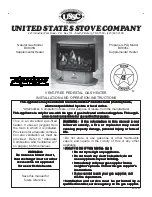
– 7 –
The appliance must be isolated from the gas supply pip-
ing system by closing it’s individual manual shutoff valve
during any pressure testing of the gas supply piping
system at test pressure equal to or less than 1/2 PSIG.
Correctly sized piping must be run to the unit.
Regulator Venting
NOTE:
Regulators and devices that have vent limiting
orifi ces installed do not require a vent line.
a.) Keep the vent line length as short as possible
to minimize the restriction and reduce the vent’s
tendency to cause regulator pulsation .
b.) Never use pipe sizes smaller than the vent size;
smaller pipe sizes restrict the gas fl ow. If a long gas
vent line length must be used, you should increase
the pipe one nominal size for every ten feet of run
to keep the fl ow restriction as low as possible.
c.) Support the vent line to eliminate strain on the
regulator diaphragm case.
d.) Always point outdoor vent lines in the downward
position to reduce the possibility of rain, snow,
sleet, and other moisture entering the pipe. Install a
bug screen in the end on the vent line.
e.) Do not locate the vent line terminus near windows,
fans, or other ventilation equipment.
f.) Adhere to all applicable codes and regulations.
g.) If your vent line causes regulator pulsation, consult
your local sales representative or the factory.
h.) We strongly recommend running a separate
vent line for each regulator. Headers with various
installed devices can cause regulator malfunction.
CAUTION: Ensure the vent line is away from ANY
potential ignition sources. It is the installer’s responsibility
to ensure the vent line is exhausting to a safe
environment.
Please note that gas line pressure must be
as shown on specifi cation plate when unit is
operating at full input. The high-pressure regulator
and relief valve should be, if possible, mounted
at least 5 to 10 feet upstream from the appliance
regulator on the unit (if possible).
Building Pressure Transducer Piping (PT-13)
Pipe the high side to location inside the building that
will not be affected by air movement. Pipe the low side
to the atmosphere, positioned so it will not be affected
by the wind and not exposed to the elements. Be sure
that all tubing is clean and clear of any debris before
installing tubes on the transducer.
Flow Station Transducer Piping (PT-15)
Pipe the high side to the upstream connection and
low side to the downstream connection of the Airfl ow
Station as shown in Drawing # C000643 below. Be
sure that all tubing is clean and clear of any debris
before installing tubes on the transducer.
Refrigerant Piping
Evaporator Coil – Blow Through
The cooling coil section is located in the unit so that
the supply air is blown through the evaporative coil(s).
A properly piped trap should be installed to control
the condensate fl ow from the unit and also eliminate
conditioned air from being blown out the condensate
drain.
See Drawing #C000659B.
Since the condensate is drained by gravity, avoid long
runs of drain piping. If a long run of piping cannot be
avoided or the piping has water fl ow restrictions, such
as several elbows; add extra height to provide enough
hydrostatic head to overcome the frictional losses.
Always slope piping down a minimum of 1/8” per foot
in the direction of the fl ow.
On initial start-up, it may be necessary to fi ll the
trap manually or allow the unit to operate only long
enough for a small amount of condensate to collect in
the drain pan. Then turn off the unit and the trap will
automatically fi ll.
G. Field Wiring and Remote Control Installation
1. Connect the power lines to the line side of the main
disconnect switch.
2. Mount and wire remote control panel, thermostats,
temperature sensors, and any other fi eld installed
controls as indicated on the unit control wiring diagram.
3. Connect the wires to the appropriate fi eld wiring
terminals as indicated on the unit control wiring diagram.
4. Field wiring shall have a temperature rating of at
least 105°C. The minimum size of the supply cable
circuit shall be suffi cient for the maximum ampacity
of the heater.
L'installation éléctrique d'utilisateur aura une
température qui évalue d'au moins 105°C. La
minimum de source du circuit de câblage sera
suffi sante pour le ampacity maximum de l'appareil
de chauffage.
H. Locating Temperature Controls
The room or outdoor sensors should be mounted
where they will not be subjected to direct impact of
the heated air or radiant heat from the sun. It is also
recommended that thermostats, especially those with
mercury bulb contacts, be mounted on a vibration free
surface. The side of building columns away from the
heater or interior walls are usually the location best
suited for mounting thermostats.
Controls with outdoor sensors require that the outdoor
sensor be shielded from direct radiation from the sun. Unit
mounted sensors are factory located and mounted.
Содержание IOMDFCDFM-1
Страница 43: ... 43 ...
Страница 44: ...4830 Transport Drive Dallas TX 75247 Phone 214 638 6010 Fax 214 905 0806 www appliedair com ...








































